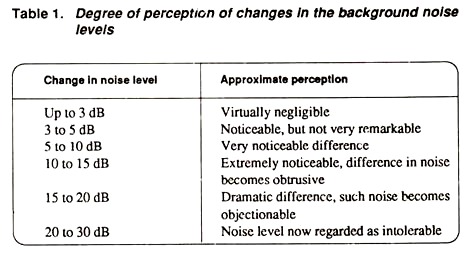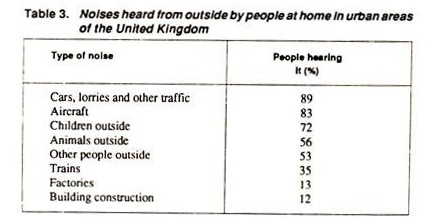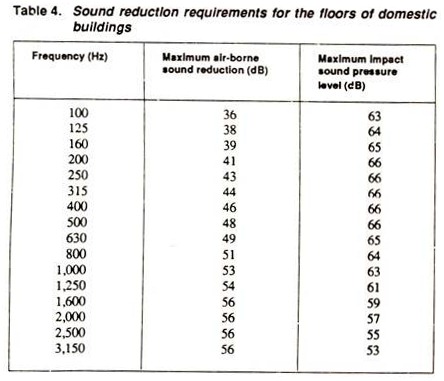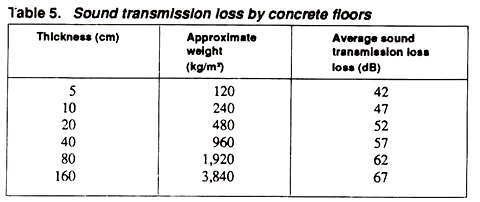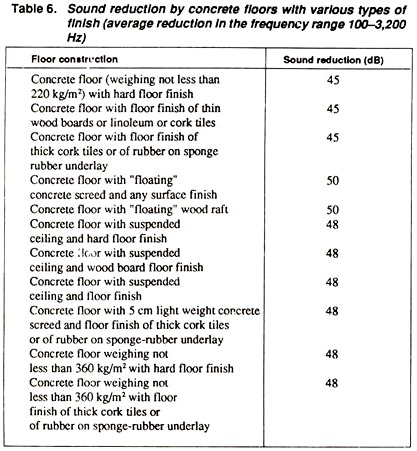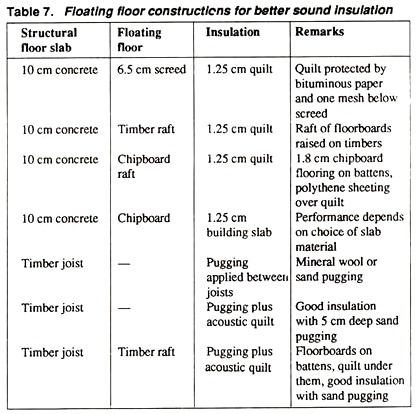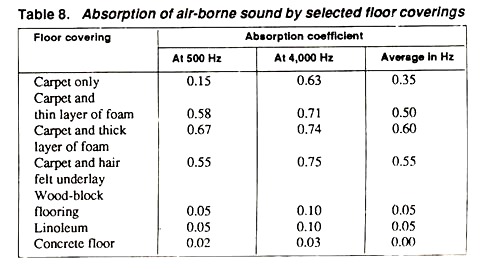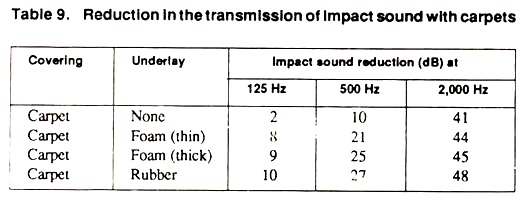Building codes and standards regarding noise levels are available in most of the industrialised countries of the world. Such standards generally set minimum requirements for sound insulation or sound reduction. Individuals, however, may set considerably higher standards of performance to suit their requirements.
When this is the case, further consideration and acoustical treatment may be necessary, especially where noisy environments are concerned.
Even in highly industrialised nations, however, most of the domestic buildings were constructed before the standards for sound insulation in buildings were formulated in the 1960s or later. It follows, therefore, that existing domestic buildings may be deficient in respect of minimum acoustical requirements.
Obligatory minimum standards for new buildings in the United Kingdom and many other developed countries are largely based on two aspects of acoustic performance, viz.:
(a) Minimum standards for insulation against air-borne noise; and
(b) Maximum sound levels for the transmission of impact noise.
These two aspects of noise problem in domestic buildings happen to be the main sources of criticism and complaints regarding neighbourhood noise.
Background Noise Level:
The background noise level inside a domestic building is generally determined by the noise outside the building and also the degree of attenuation provided by the dwelling structure. The noise generated within the building itself may not be objectionable, unless arising due to a very noisy appliance. Moreover, the noise produced within the building is directly controllable.
Any other noise will only be intrusive if its level is equal to, or greater than, the background noise level already present within the building. It may then produce a perceptible rise in the normal ambient noise level.
The approximate degree of perception of such changes in the background noise levels is shown in table 1. The figures in this Table are related to a “normal” background noise level of 50-55 dB (A), which is typical of urban areas.
Internal noise in a domestic building may be air-borne or structural-borne. It may even be a combination of both of these types, e.g., the impact noise produced by the slamming of doors. The most common single source of complaint in the case of domestic buildings is the over-loud radio and TV, the banging noises coming next.
Other common sources of objectionable indoor noise in domestic buildings are noisy children, shouting or over-loud conversation. Table 2 shows the percentage of people annoyed at home by outside traffic, according to a survey in the United Kingdom.
The potential sources of noise as well as the degree of annoyance they cause are dependent on the type and location of the building. Flats, for example, tend to be noisier than houses.
In the same way, terraced or semi-detached houses are more subject to intrusive noise than detached houses. In particular, flats have more potential sources of neighbourhood noise (such as other flats, lifts, access ways, etc.) than other types of dwellings. Table 3 shows the noises heard from outside by people at home.
Night-time Noise Levels:
The normal pattern of sleep consists of four different stages varying from light dozing to deep sleep. Among these, the fourth stage (i.e., deep sleep) is most beneficial to the sleeper. This pattern of sleep is irregular.
It contains periods of awakening or near-awakening, and separate periods of deep sleep. The pattern of sleep changes with age. The young adults, for example, tend to be awake roughly 5% of the night. People over the age of 40, on the other hand, can be awake up to 40% of the night or even more.
Even when a person is asleep, the ear is still picking up sound, but the brain reacts differently to the stimuli received during the sleep. The general effect of intrusive noise during sleep is to cause a shift in the sleep level. Even this effect, however, changes markedly with age.
Young people, for example, are rarely awakened, or even shifted to lighter levels of sleep, by noise below 70 dB (A). Older people, on the other hand, are readily awakened by much lower noise levels.
For young as well as old people, however, steady noise levels have less effect than intermittent peak noises or fluctuating noise levels. Elimination of such noise peaks, therefore, is more significant than achieving a low level of ambient noise.
It has been found that a background noise level not exceeding 40 dB(A) is acceptable for undisturbed sleep; but a preferable maximum noise level for this purpose is 35 dB(A). In order to be unobtrusive, moreover, peak noise levels should not exceed 50 dB (A) in the case of young people, and 35 dB (A) for old people.
Impact Insulation:
In multi-storied domestic buildings, the sound of footsteps on the floor above is a very common cause of complaints. This is especially true of monolithic or steel – framed structures, where the continuous construction provides very little attenuation of the mechanical vibrations travelling down the walls. Brick-built flats, on the other hand, are much less prone to troubles caused by impact.
The Building Standards (in countries where they are available) generally specify the maximum sound levels that can be tolerated in the room below a floor when a standard tapping machine is operated on the floor. The values recommended by such standards attempt a realistic compromise between cost and the desirable target.
A few tenants are likely to complain even when the impact insulation in a dwelling meets the requirements of Building Standards. On the other hand, complaints increase rapidly if the performance of the floor falls even a few dB below the prescribed standard.
Experience has shown that 22.5 cm thick brick walls provide sufficient insulation for air-borne noise in semi-detached and terraced houses, and economic alternative to these appears to be feasible at present. With the insulation provided by such brick walls, the noise from neighbours is reduced to a level that is acceptable to most people. A higher degree of insulation would be desirable; but it is not yet generally practicable by known simple and economic methods.
Floors:
Floors in a domestic building should effectively insulate sound. In order to achieve this goal, the flooring needs to provide a desirable degree of attenuation of air-borne sound and also to minimise the impact noises (caused by footsteps) and vibrations (caused by cleaning equipment and other sources).
Reduction of airborne sound can be achieved, in general, by a suitable mass of floor structure. Impact sound insulation, on the other hand, is best provided by isolating the floor surface from the structure unit. This type of isolation is achieved by the so-called “floating floor”, where the necessary floor mass is carried on a resilient insulating cushion or quilt or acoustic isolation pads.
Building Standards, where available, usually require that separating floors between dwellings (and in conjunction with the associated elements of structure) provide adequate resistance to the transmission of air-borne as well as impact sound Table 4 shows the requirements of sound reduction, for the floors of domestic buildings, according to the Building Regulations (1972) of Great Britain.
The acceptable tolerance for compliance with the standards of these regulations is achieved if the aggregate of adverse deviations from the specific, recommended values for each frequency listed in Table 4 does not exceed 23 dB.
The best performance at present can be attained by a “floating” concrete floor. When these are used in domestic buildings, the noise from neighbours will only be a minor nuisance.
Concrete Floors:
In terms of air-borne sound reduction, a 5 cm thick solid concrete floor will have an average sound transmission loss of about 42 dB. Since the absorption of sound follows the mass law, each doubling of the floor thickness will result in an improvement in sound reduction of only 5 dB.
It is obvious, therefore, that the possible reduction of sound is limited by the practical consideration of the weight of concrete floor, as shown in Table 5.
In practice, a solid 10 cm thick concrete floor slab will give sufficient insulation to air-borne sound. Such a floor may not be satisfactory for the insulation of impact sound. This, however, can be improved by a soft surface layer (e.g., cork tiles, carpet, or rubber flooring) on the concrete floor.
Sound reduction properties of concrete floors finished with various types of soft surfaces are shown in Table 6. The details of other types of “floating” floor constructions using a quilt or blanket acoustic-insulation intermediate layer are given in Table 7. Such floor constructions provide a better insulation for both air-borne and impact noise.
An alternative approach is a greater separation of floor slabs and basic structural slabs on resilient supports, including a substantial air space between them. This arrangement can provide a much better attenuation of sound compared with concrete slabs of similar overall thickness. A possible disadvantage with this type of floating-floor construction is the increased overall depth of the floor.
On the other hand, this particular form of floating floor lends itself to further treatment for critical applications, when virtually complete freedom from the transmitted sound and vibrations is required.
The floor slab can be floated on isolation mounts and the intervening spaces filled with acoustic blanket or quilt material. Machines or equipment carried on the floor are mounted on high-deflection spring isolators. Finally, an acoustic ceiling can be suspended from the structural floor slab.
Carpets:
Carpets applied over flooring offer the possibility of achieving a noise reduction coefficient of up to 0.60 or approximately three times that provided by the wood-block floor or even linoleum covering, as shown in Table 8. This table gives the overall absorption coefficient and that at low and high frequencies (500 Hz and 4,000 Hz, respectively) for various types of floor coverings by carpets and other materials.
Another advantage of carpeting is that the absorption of sound provided by it is greatest at higher frequencies (as seen in Table 8), which are usually the most irritating components of noise spectrum.
In addition, carpet is also effective in reducing the transmission of impact noise through the floor, and the surface radiation of noise generated in the floor of the room itself (by footsteps, scraping of furniture over the floor, etc.).
The performance of carpeting as an acoustic absorbent depends mostly on the type of fibre employed. For example, wool, nylon and acrylic fibre carpeting of similar thickness all give about the same absorption coefficients at similar frequencies. Moreover, the performance of carpets made from these and other materials is not much affected by texture.
In fact, the significant parameters with respect to the absorption of sound by carpeting are:
(a) The depth and density of pile; and
(b) The type and thickness of backing and/or underlay.
The coefficient of sound absorption of carpeting increases with increasing height of the pile, as expected. This, moreover, occurs over almost the whole range of frequency. The effect of pile density, however, is more frequency dependent.
The insulation offered by carpeting, both for air-borne and impact sound, is much improved by the use of an underlay. All types of underlay are effective for sound insulation and absorption, provided they are reasonably thick. It has been found that sound absorption increases with increasing thickness (or weight) of the underlay.
From this point of view, high-density foam backings or foam underlays are more effective than felt or hair underlays. Typical reductions in the transmission of impact sound obtained with carpeting and different types of underlays on a concrete floor are shown in Table 9.
